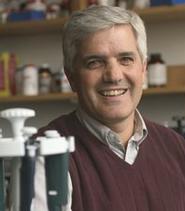
As members of a panel sponsored by the Council on Undergraduate Research (CUR) at the National Press Club, Professor of Chemistry Tim Elgren and neuroscience major Kateri Whitebean '08 spoke on the value of undergraduate research. The event, held on Feb. 21, was organized to spark a national conversation on the topic by introducing CUR's new publication, Developing and Sustaining a Research-Supportive Curriculum: A Compendium of Successful Practices. Elgren and Kerry Karukstis, professor of chemistry at Harvey Mudd College who was also a presenter, co-edited the volume. Lori Bettison-Varga, associate dean at the College of Wooster also served as a presenter. Chris Hollinsed, director of the American Chemical Society's Petroleum Research Fund, introduced the panel.
Whitebean, the only student on the panel, spent her pre-freshman and sophomore summers analyzing honeybee behavior maturation. She started her presentation by talking about growing up in a small rural Upstate New York town. She was first exposed to college-level research in high school when she took part in a two-summer exploratory science program coordinated by the Oneida Indian Nation and Hamilton College. The experience helped her define the kind of college she wanted to attend, one that emphasized a collaboration with teachers and students and was committed to undergraduate research and academic excellence.
Hamilton fit her requirements, but, as a bonus, she "fell in love with the caring atmosphere that the professors and college presented." The summer before her first year, she joined nine other students in a special research program for entering first-year students. Whitebean says that this experience was helpful in her transition into college life and her decision to pursue a major in science. Her continued participation in undergraduate research added to this interest.
After graduation Whitebean wants to obtain a masters degree in education and become a high school science teacher. "Undergraduate research was an integral part of my college experience," she said. "It was the springboard that got me hooked. I believe that providing exceptional research opportunities is the essence of a great college." Whitebean gained invaluable skills by "knowing how to ask questions, knowing where to find the answers. The confidence and experience, the independence and the ability to work through the process…these have made me a more successful student in all aspects."
"You're a tough act to follow," Hollinsed said to Whitebean as he took to the podium. He believes that Whitebeans's generation represents the people who are going to be at the forefront of cutting edge research.
Elgren wrapped up the conference by describing how much undergraduate research has evolved. When CUR started there were 10 participating member institutions. Now there are more than 500. He stressed that undergraduate research is not only limited to places like Hamilton or Harvey Mudd College, but to institutions all over America. He said that "research experiences bring science to life. It brings students into the act of doing science. It helps with the transformation from science student to scientist." Using Whitebean as a prime example, Elgren said that "students learn science by doing science, but it's not limited to science. Students learn by getting engaged in open-ended research."
At the conclusion of the presentations, panel members fielded questions from the media and educators in the audience. A report on the event may be found on InsidehigherEd.com.
Whitebean, the only student on the panel, spent her pre-freshman and sophomore summers analyzing honeybee behavior maturation. She started her presentation by talking about growing up in a small rural Upstate New York town. She was first exposed to college-level research in high school when she took part in a two-summer exploratory science program coordinated by the Oneida Indian Nation and Hamilton College. The experience helped her define the kind of college she wanted to attend, one that emphasized a collaboration with teachers and students and was committed to undergraduate research and academic excellence.
Hamilton fit her requirements, but, as a bonus, she "fell in love with the caring atmosphere that the professors and college presented." The summer before her first year, she joined nine other students in a special research program for entering first-year students. Whitebean says that this experience was helpful in her transition into college life and her decision to pursue a major in science. Her continued participation in undergraduate research added to this interest.
After graduation Whitebean wants to obtain a masters degree in education and become a high school science teacher. "Undergraduate research was an integral part of my college experience," she said. "It was the springboard that got me hooked. I believe that providing exceptional research opportunities is the essence of a great college." Whitebean gained invaluable skills by "knowing how to ask questions, knowing where to find the answers. The confidence and experience, the independence and the ability to work through the process…these have made me a more successful student in all aspects."
"You're a tough act to follow," Hollinsed said to Whitebean as he took to the podium. He believes that Whitebeans's generation represents the people who are going to be at the forefront of cutting edge research.
Elgren wrapped up the conference by describing how much undergraduate research has evolved. When CUR started there were 10 participating member institutions. Now there are more than 500. He stressed that undergraduate research is not only limited to places like Hamilton or Harvey Mudd College, but to institutions all over America. He said that "research experiences bring science to life. It brings students into the act of doing science. It helps with the transformation from science student to scientist." Using Whitebean as a prime example, Elgren said that "students learn science by doing science, but it's not limited to science. Students learn by getting engaged in open-ended research."
At the conclusion of the presentations, panel members fielded questions from the media and educators in the audience. A report on the event may be found on InsidehigherEd.com.
by - Eric Kuhn '09
Posted February 22, 2007
